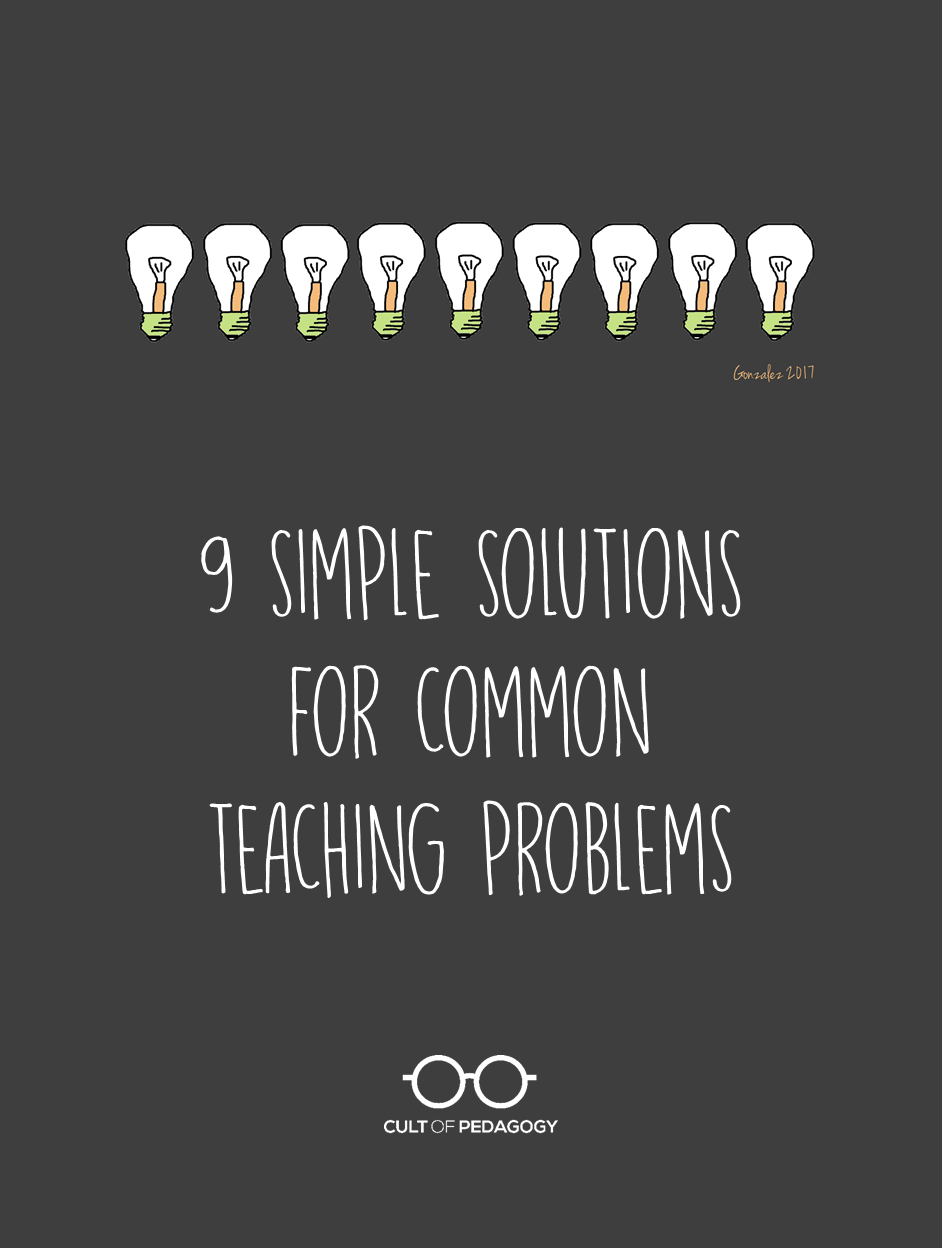
Listen to my interview with Mark Barnes (transcript):
This post contains Amazon Affiliate links; if you make a purchase from Amazon after going there through these links, Cult of Pedagogy receives a small commission at no extra cost to you. Thanks.
It’s pretty easy to avoid solving problems. It happens to everyone: A good chunk of the year has passed, you’ve got a routine going, and whatever problems you might have, you’ve basically accepted them for now. Fixing them would take too much time. The solution would probably be too complicated.
Not necessarily.
My buddy Mark Barnes, a veteran teacher and author of six education books, thinks the solutions to many of our education challenges are things we could start doing tomorrow. This philosophy was the guiding principle behind the 2015 book we wrote together, Hacking Education: 10 Quick Fixes for Every School. Since then, Barnes has published eight other Hack Learning books. He knows you don’t have time to read stacks of research-heavy, theoretical books. You want answers you can use right away. With this series, he aims to give educators “hacks”—solutions that can be implemented right now.
To give you a sampling of the kinds of solutions you’ll find in this series, we’re going to look at one idea from each book: Nine simple ideas that can have a big impact on student learning at your school. Although each hack has a blueprint for full implementation in the book it comes from, we’ll look at how you can get started right away. By the time you’re done reading, you should have found one you can try at your school. Let’s go.
1. Student Tech Gurus
From Hacking Education: 10 Quick Fixes for Every School
The Problem: Not enough tech support in your school. You have the tech, but when teachers or students need help, or something goes wrong, everything comes to a standstill because your current tech support staff doesn’t have the manpower to handle it all.
The Solution: Some schools are training teams of students to provide basic-level tech support for the school, even at the elementary level. These students attend staff trainings on new technology, act as teaching assistants when a class is working with a new or challenging technology, and even conduct their own training sessions for students and teachers. If students are trained to handle and prevent the lower-level problems, this frees up the paid tech support staff to focus on the more complex issues.
What You Can Do Tomorrow: Establishing a true tech team takes some time, but right away, you can make a list of students you know to be pretty tech-savvy. Beside their names, list the tools each student is proficient in. Put this list in a public location in your classroom. Then, the next time students are working with a piece of technology, have them go to the students who know that tool for help.
2. Inspiration Boards
From Make Writing: 5 Teaching Strategies that Turn Writer’s Workshop into a Maker Space
The Problem: In writing classes, students are sometimes slow to come up with ideas for what to write about.
The Solution: Dedicate a wall in your classroom as an Inspiration Board, a place where students can place images, quotes, rough ideas, the opening lines of a story they’re thinking of writing, anything that inspires them or shows fragments of inspiration. This gets the ideas out of students’ heads and into a public space, where they can generate fresh new ideas. “Students put an idea up, and then someone else maybe will see that idea and go, ‘Oh, I like that, and that makes me think of this,'” Barnes explains. “They’re getting thoughts out onto a board, and then starting to discuss those ideas, and ultimately those turn into those stories and projects and pieces of writing.”
What You Can Do Tomorrow: Clear everything off one of your bulletin boards and ask students to bring in something to hang on the board that inspires them—this can be a quote, an image, a poem, anything that can be affixed to a board. You may need to model this at first to get things going. If you teach more than one class period of writers, you could create separate boards for every class or just mix it all together.
3. Tracking Progress Transparently
From Hacking Assessment: 10 Ways to Go Gradeless in a Traditional Grades School
The Problem: Traditional grade books provide a very limited picture of a student’s progress, and students have no ownership of tracking their growth.
The Solution: Have students keep a record of their own progress in a “transparent” space—a Google doc, for example—where the student, teacher, and parents can view it any time. The information they record will vary depending on student age and subject area, but the document will become more valuable if you require students to go beyond numbers: Record each assignment, the feedback they got on it, the standard(s) being measured, and what goals they set in response to the feedback.
What You Can Do Tomorrow: Choose the record-keeping system you’re going to use—ideally, it will be something in the cloud, such as a Google Doc, but it can even be a chart on paper. Have students record the results of their most recent assignment, including the feedback they got and a goal for future growth, based on that feedback. Tell students you’re still just trying this out and get their feedback on how the system should evolve over time.
4. “Morecabulary”
From Hacking the Common Core: 10 Strategies for Amazing Learning in a Standardized World
The Problem: Students need to grow their vocabulary in all subject areas, but our most common methods of vocabulary instruction are dry and don’t lead to long-term retention.
The Solution: Instead of doing traditional dictionary and sentence-writing work, have students construct the meaning of vocabulary words in a variety of ways. One way of doing this is with a tool like Padlet, which is like an online corkboard. By creating a Padlet board for each word, students can all contribute their own definitions, sentences, even links to videos or articles that use the word in context. This kind of varied work will give students a more well-rounded, memorable experience with each word, and they’ll have more fun doing it, too.
What You Can Do Tomorrow: Get started with one word: Choose a term students typically get wrong in your subject area and create a Padlet for it. (If your school is light on tech, you can use a sheet of paper or part of a bulletin board instead.) Then take 15 minutes and have students contribute definitions, sentences, images, videos, or other resources to flesh out the meaning of that word. Stay involved in the process, so you can correct any misconceptions. Once kids are used to the process, it can be repeated for other words.
5. Broadcast Student Voices
From Hacking Leadership: 10 Ways Great Leaders Inspire Learning that Teachers, Students, and Parents Love
The Problem: Most educators say they want to “give students a voice,” but they don’t always know how to make that happen.
The Solution: Using podcasting and live streaming, we can literally broadcast student voices right out into our schools and communities. Students can talk about topics or events that matter to them, or they can even share their own writing pieces or class projects. Links to these podcasts and broadcasts can be shared through the school website, newsletter, or social media account.
What You Can Do Tomorrow: You can literally have students record and publish a podcast tomorrow using a free tool like Spreaker, which allows users to record podcasts right from a mobile device. For the sake of time, you might want to provide students with a starter topic or question, but once students get used to having a platform, let them take the reins.
6. OPB (Other People’s Books)
From Hacking Literacy: 5 Ways to Turn Any Classroom into a Culture of Readers
The Problem: Students need to be reading for pleasure, but your classroom doesn’t have enough books, and you can’t afford to buy any more.
The Solution: Build a massive classroom library with Other People’s Books—used books donated by parents, community members, and local businesses. Most people have a few books around the house that they’d be happy to donate; they just need to be asked. Then contact your public library—most libraries regularly purge their shelves of books to make room for new ones, and many would be happy to donate these to a classroom. Keep in mind that these books don’t have to be fiction: Student reading proficiency will grow if they read cookbooks, DIY home project books, old copies of the Guinness Book of World Records, really anything that isn’t inappropriate for school.
What You Can Do Tomorrow: Send an email out to staff and parents, explaining what you’re attempting to do and asking them to send in used books. Then start clearing some shelves!
7. Celebrity Couple Nickname Game
From Hacking Engagement: 50 Tips & Tools to Engage Teachers and Learners Daily
The Problem: Learning student names is essential for relationship-building, but it’s hard to learn lots of names quickly.
The Solution: In the same way that the media creates mashups of celebrity couples’ names (think Brangelina), you can construct similar mashups to create unique nicknames for students using their first and last name: Jason Matthews becomes JMat. Rhianna Johnson becomes RJo. Have students offer their own suggestions until you find one that’s just right. Although you will eventually need to learn students’ real names, these nicknames can help jar your memory more quickly than a standard list of names will.
What You Can Do Tomorrow: Obviously, if you’re reading this close to the beginning of a school year, you can plan to play this game with your students soon. But even if you’re way into the year and you already know everyone’s name, the game would make a fun bonding activity when you have a few spare minutes.
8. Boomerang Model
From Hacking Homework: 10 Strategies that Inspire Learning Outside the Classroom
The Problem: Students lack independent problem-solving skills when it comes to homework, relying too often on parents to “tell them how to do it.”
The Solution: Teach parents how to use the Boomerang Model, which empowers students to find solutions to their own homework problems. Barnes explains: “So they come to me, and they say, ‘Dad, I need help with this. I don’t get it.’ I’m going to respond with, ‘How can you help yourself? What strategy can you use that maybe you haven’t tried yet? Where should you start, because maybe you missed the real starting point? What evidence do you have to support this?’ If they say, ‘Is this right? Should I do this this way?’ I can say, ‘Well, what evidence do you have?’ We don’t want their automatic response to a struggle to be, ‘I need help from a teacher,’ or ‘I need help from a parent.’ We want them to help themselves.”
What You Can Do Tomorrow: Create a list of questions parents can “boomerang back” to their kids, then practice using them yourself, so students get used to hearing and responding to them. Introduce this concept to parents in a newsletter or better yet, a video demonstrating how it’s done.
9. Question Carousel
From Hacking Project-Based Learning: 10 Easy Steps to PBL and Inquiry in the Classroom
The Problem: When students work on a group project, they sometimes need fresh ideas to see the project or problem from all sides.
The Solution: The Question Carousel starts with students working in groups to generate something unique: A draft of an idea, a solution to a problem, the beginnings of a presentation of some kind. Then students rotate with their groups to study other groups’ products. At each stop, they leave questions for the original group; these questions help to clarify the product, clear up misunderstandings, point out problems, and fine-tune the final outcome.
What You Can Do Tomorrow: The next time you put students in groups to generate some kind of unique idea or solution, have students rotate in a Question Carousel to prompt deeper thinking.
Browse the Complete Hack Learning Series Library
The ideas presented here are just a small fraction of the solutions you’ll find in each of the Hack Learning books. More books are being added all the time (and the three below are just a few), so click here to see what’s new.
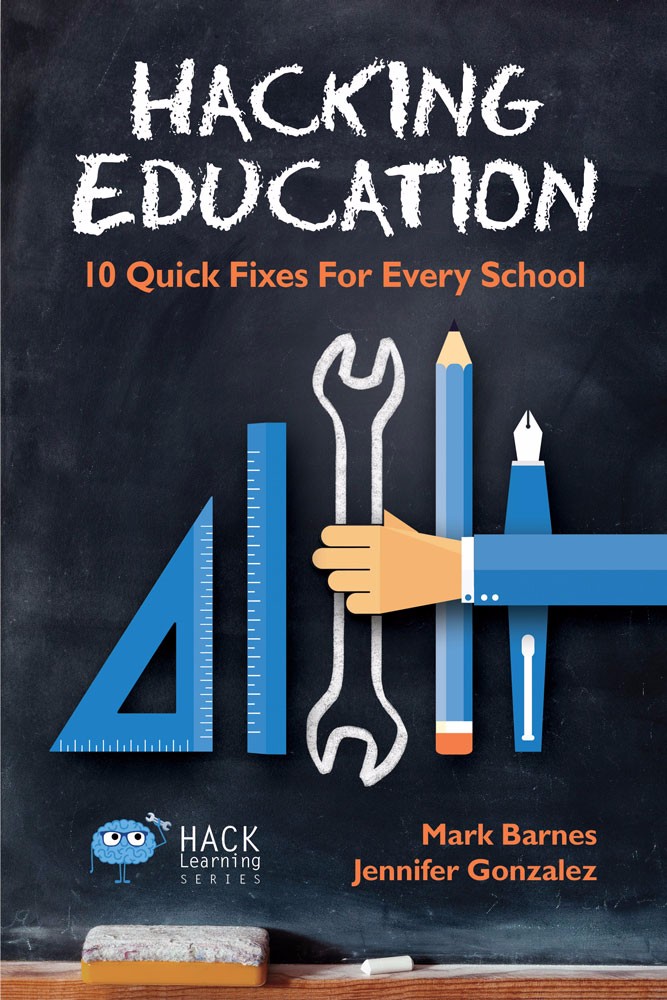
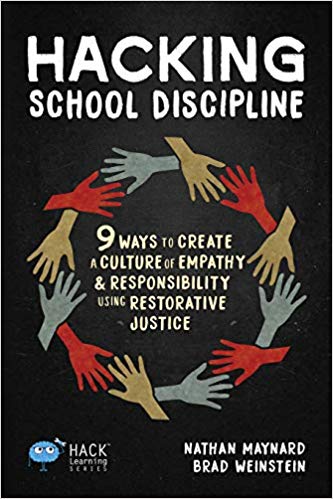
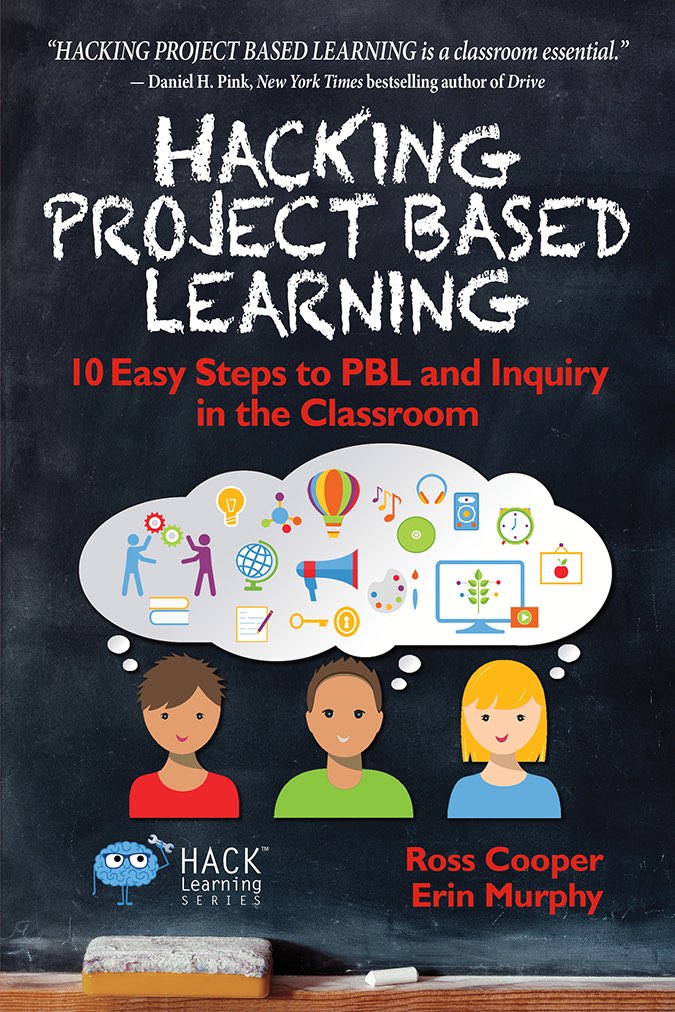
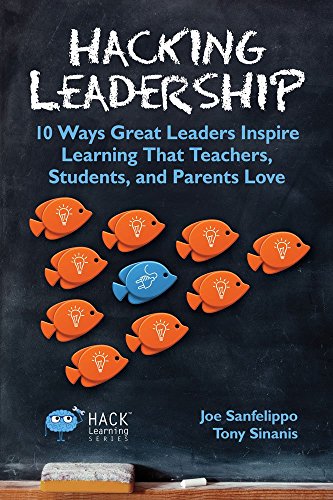
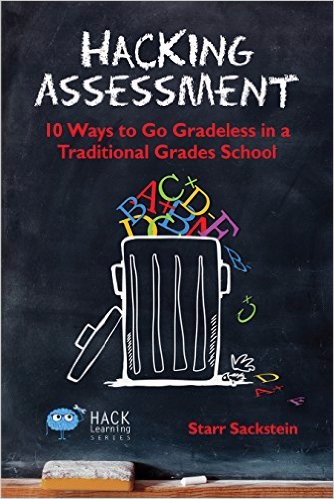
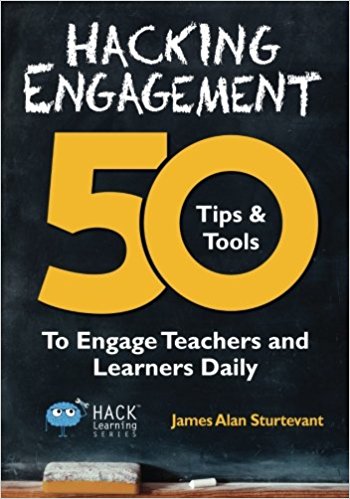
Join my mailing list and get weekly tips, tools, and inspiration all geared toward making your teaching more effective and fun. You’ll also get access to my members-only library of free resources, including my e-booklet, 20 Ways to Cut Your Grading Time in Half, which has helped thousands of teachers spend less time grading!




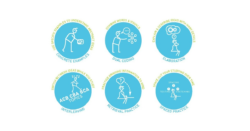

Hey Jen,
Among many personal aspects to my life I am also thankful for your blog/posts/thoughts. It’s always a nice break to hear your voice pulling my thoughts not just to best teaching practices but to my student’s needs.
Quick Question: Where’s the best place to purchase an entire set of your Hacking series books. i’m thinking of Christmas gifts for my PLC.
–jeff
Renton HS, Renton, WA
Hi Jeff! Can you tell me how many people this would include?
Jen,
Discovery of your podcasts and website has enriched my own pedagogy and now that of my teaching candidates. As an art educator working with undergraduates in the field, it has been a mission of mine to broaden their understanding of becoming an art teacher beyond area specific content knowledge. As you inspire me, I hope to inspire them! Thank you for quenching a thirst. Have you already given away the books you mentioned??
Hi Jen & Marc
It is interesting that I discovered all this great Hacks Books last week. I was in my bed reading about Hyperdocs and suddenly the great Amazon suggested me Hacking the Homework. I read the first sample and then the other titles appeared. I read all the samples including Hacking the Assessment, which was one of my favorites. I was unsure which one to buy that night, I picked 50 Hacks to Engagement. Just love it! My favorite part is the one Things that I Could do Tomorrow. Great work, I’ll buy more books in this series. Awesome tools to Hacks my teaching practice.
Hi Jen,
I was really interested in your problem #8 where students have trouble problem solving on homework and rely too heavily on their parents for help. I’m a preservice math teacher, so we really aim to help students become good problem solvers. I thought your proposed idea of teaching parents how to use the Boomerang Model of responding to their children’s questions with targeted questions that empower students to find their own solutions was a really great idea because it reinforces what they’re being asked to do in the classroom. I also really liked your next steps of compiling a list of example questions for parents or making an example video. My only thought is that some parents might not see the benefit in this approach and might see it as being more work for them. How would you justify the boomerang method to a parent that isn’t convinced it’s useful?
I love all the topics …in this websites hope i have all …
Im a teacher who wants more knowledge…
Thanks for an interesting set of solutions for common teaching problems. I was disappointed by only one: #6, OPB. No mention of a library or librarian in this one? School librarians are eager to partner with teachers to promote outside reading and they are experts in the best, most appealing books for the kids they work with. Town librarians are also great sources of support and information. A teacher doesn’t have to go it alone when it comes to promoting outside reading.
Hi Suzanne,
Thank you for the reminder. I absolutely did not mean to ignore the value of librarians here! The focus of the post was to give teachers actions they could take all on their own, without needing to depend on a school budget. In schools that have an abundance of books in the library, a lack of books may not really be an issue. But for underfunded schools, teachers may need to be more resourceful. I’m glad you pointed out the knowledge of librarians in terms of knowing what books would be the most appealing; regardless of a school’s budget, that kind of knowledge will always be incredibly useful.
Great point, Suzanne. I recently paired with the awesome librarian at my school for a thematic book walk. Our librarian, Amy, set up around the library dozens of books that related to our current unit of study. They were categorized by genre. Students spent time browsing the selections and choosing a book. It was a great way to expand the classroom library and integrate the school library into our class.
Thanks for sharing this, Jenn.
Unfortunately, in a district like mine, the librarians and media specialists have all been removed in the high schools due to budget constraints. The “media specialist” now is just a temp duty person or a school aide. The media center has become somewhere to store textbooks and checkout Chromebooks, but it is no longer the place to get real books or learn from the specialist working there. It is very, very sad.
Loved this episode! It got me excited to read and reread the Hacking books. So practical and inspiring! Thanks!!
Great work!